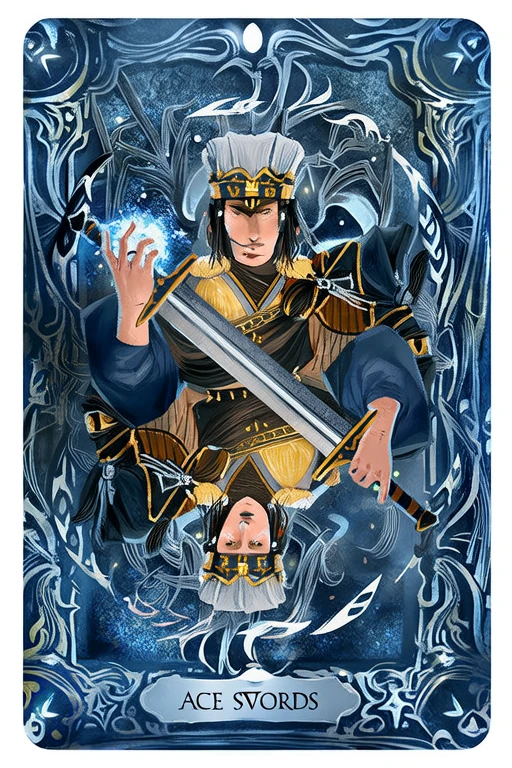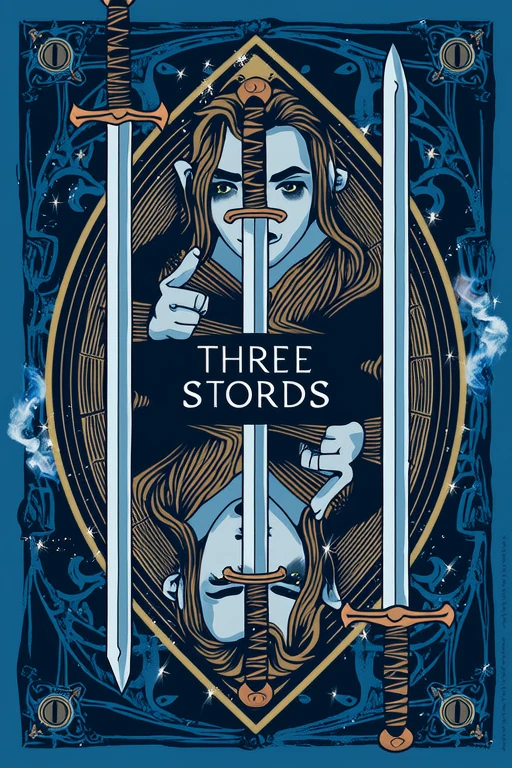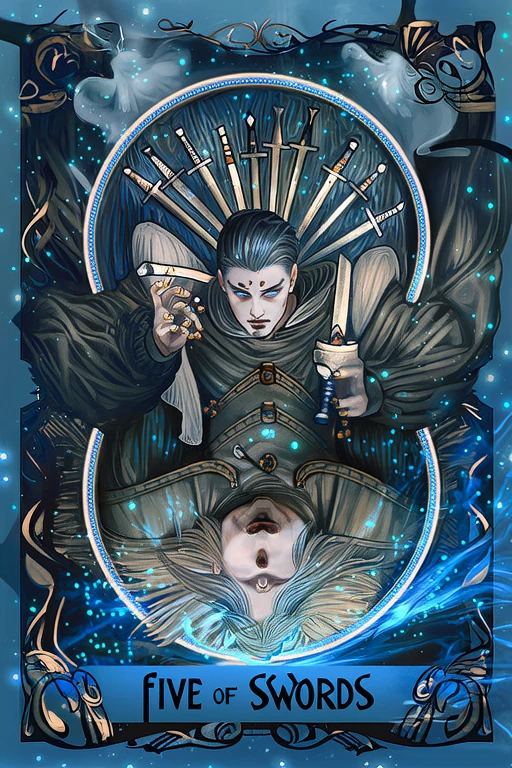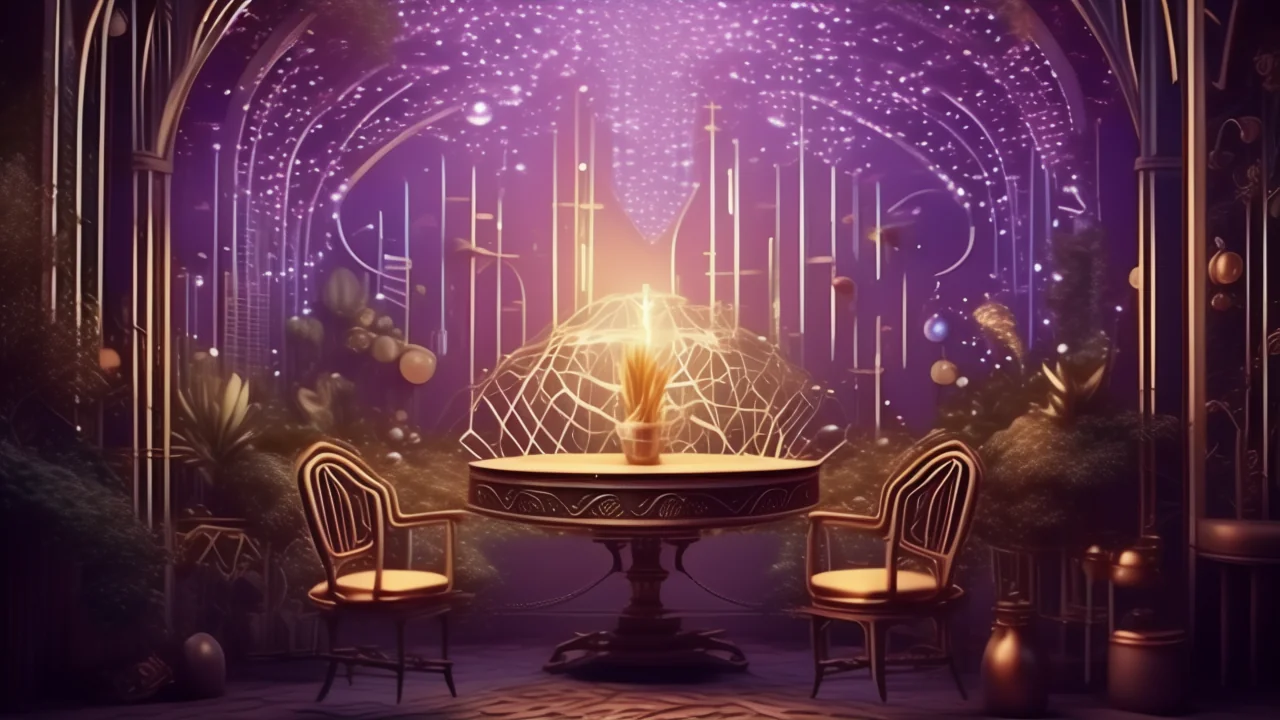
Two of Swords
Discover the deep meaning of Two of Swords with our free AI-powered tarot interpretation. Get instant, accurate readings based on advanced tarot knowledge.
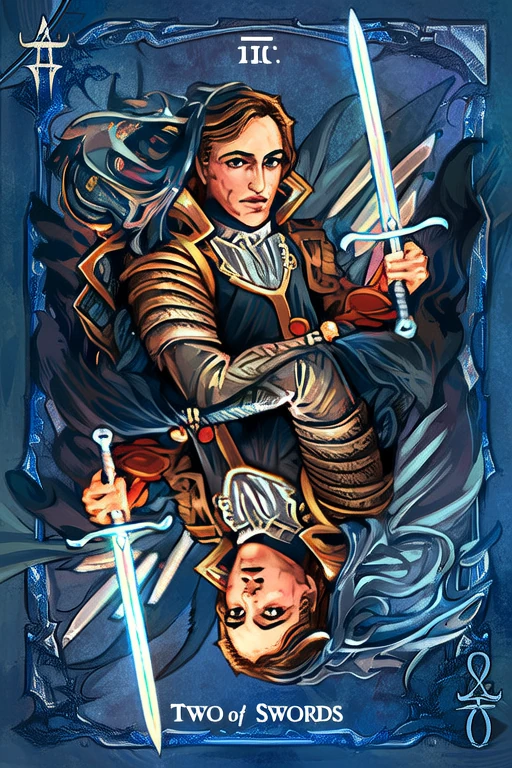
Keywords
Upright Meaning
Difficult decisions, indecision, stalemate
Reversed Meaning
No right choice, confusion, release
Full Interpretation
The Two of Swords represents difficult decisions, indecision, and the need to choose.
In-Depth Analysis
📜 Historical Background
The Two of Swords is a Minor Arcana card from the suit of Swords in traditional tarot decks, often associated with the element of Air and the mental or intellectual aspects of life. Its origins trace back to early tarot decks such as the 15th-century Visconti-Sforza and Marseille decks, which laid the foundation for modern tarot symbolism. In these early decks, the imagery was often simplistic and symbolic, focusing on the number and suit rather than detailed narrative scenes. The Two of Swords was typically depicted as two crossed swords, sometimes with a wreath or other symbolic elements, representing balance, duality, and intellectual tension.
As tarot evolved into a tool for divination and esoteric exploration in the 18th and 19th centuries, especially during the Hermetic Revival and the rise of the Golden Dawn, the card's symbolism became more nuanced. The Rider-Waite-Smith deck (1909), created by A.E. Waite and Pamela Colman Smith, introduced the now-iconic image of a blindfolded woman holding two crossed swords. This imagery suggested internal conflict, indecision, and the struggle between opposing forces. The blindfold symbolized denial or refusal to see a situation clearly, while the calm sea in the background hinted at emotional stillness amidst mental turmoil.
Throughout history, different tarot decks have interpreted the Two of Swords in unique ways. In the Thoth Tarot, designed by Aleister Crowley and Lady Frieda Harris, the card is titled 'Peace Truce' and features a complex geometric design with astrological symbols, emphasizing the idea of a temporary truce or mental equilibrium. Other decks, such as the Shadowscapes or Wild Unknown, may depict abstract or nature-inspired imagery, reflecting the card’s universal themes of duality and inner conflict.
Culturally, the Two of Swords resonates with themes found in mythology and philosophy, particularly the concept of weighing two difficult choices, as seen in the Judgment of Paris or the myth of Damocles. It reflects the human condition of being caught between two truths or paths, often leading to a state of paralysis or contemplation. Across cultures, the card has been interpreted as a sign of truce, hesitation, or a need for clarity, making it a powerful symbol of the mind’s struggle to find resolution in the face of conflict.
Symbolism & Imagery
The Two of Swords is rich in symbolic meaning, with each element of its imagery offering insight into the card’s deeper significance. The central figure—a blindfolded woman—represents the suppression of awareness or the refusal to confront a difficult truth. Her blindfold is a metaphor for denial, avoidance, or an inability to see both sides of a situation clearly. This can symbolize a person in denial, or someone who is deliberately avoiding making a decision because of the emotional or mental discomfort it brings.
In her hands, she holds two crossed swords, a gesture that signifies balance, tension, and conflict. The swords themselves are associated with the element of Air, representing intellect, communication, and thought. Their crossing forms an 'X' shape, a symbol often linked with decision-making, transformation, and the intersection of dualities. The swords are equal in size and weight, suggesting that the two options before the woman are equally compelling or equally unattractive, leading to a stalemate.
The background of the card—often a calm sea and a flat landscape—adds another layer of symbolism. The still water represents emotional detachment or suppression, indicating that the querent may be experiencing a situation that is emotionally draining but has been mentally compartmentalized. The horizon line, where sea meets sky, suggests a boundary between the conscious and unconscious mind, or between rational thought and deeper emotional truth.
Color symbolism in the Two of Swords varies across decks, but typically features muted or neutral tones like gray, blue, and white. These colors evoke feelings of detachment, neutrality, and contemplation. In some decks, the woman may wear a white robe, symbolizing purity of thought or the need for clarity. The number two, which governs this card, is traditionally associated with duality, partnership, and balance—further reinforcing the card’s themes of indecision and internal conflict.
Interpretations of the Two of Swords differ across cultures and tarot traditions. In some European interpretations, the card is seen as a warning against stubbornness or an inability to compromise. In contrast, in modern psychological tarot readings, it is often viewed as a necessary stage of reflection before a breakthrough or decision. In reversed position, the card may indicate a forced decision, the lifting of denial, or the consequences of indecision. Upright, it often signals a stalemate, impasse, or the need for careful deliberation.
The Two of Swords is also connected to other cards in the tarot deck. It echoes the energy of the Justice card, which deals with fairness and decision-making, and the Lovers, which represents choice and duality. Its relationship with the Five of Swords highlights the aftermath of conflict, while its connection to the Eight of Swords emphasizes the role of perception in creating emotional imprisonment. Together, these cards form a narrative of internal struggle, decision-making, and the eventual path to resolution.
Psychological Insights
From a psychological perspective, the Two of Swords resonates deeply with Carl Jung’s concept of the shadow and the process of individuation—the integration of the unconscious and conscious mind. The blindfolded figure represents the repression of awareness, often linked to the shadow self—the part of the psyche that contains denied or uncomfortable truths. The card suggests that the individual may be avoiding a necessary confrontation with reality, either out of fear, guilt, or confusion. This aligns with Jung’s idea that unresolved inner conflicts can manifest as psychological blocks or emotional paralysis.
In modern life, the Two of Swords frequently appears in readings related to decision-making, particularly when someone is caught between two difficult or equally compelling options. This card encourages the querent to examine the underlying fears or beliefs that are preventing them from moving forward. It serves as a reminder that indecision is itself a form of decision, and that remaining in a state of limbo can be more draining than choosing a path—even if it involves risk.
For personal growth and self-awareness, the Two of Swords offers a powerful lesson in facing internal contradictions. It invites the individual to remove the blindfold—symbolically acknowledging and integrating previously denied aspects of the self. This process can lead to greater clarity, authenticity, and empowerment. In therapeutic or counseling settings, the card may indicate the need for cognitive-behavioral strategies, journaling, or guided visualization to explore the root causes of hesitation or avoidance.
Modern spiritual practices often interpret the Two of Swords as a call to seek inner peace through meditation, mindfulness, or breathwork. By calming the mind and observing thoughts without judgment, individuals can gain insights into the nature of their conflicts and begin to resolve them. Some practitioners use affirmations such as 'I release my fear of making the wrong choice' or 'I trust my inner wisdom to guide me' to align with the energy of this card.
Ultimately, the Two of Swords serves as a mirror to the mind’s tendency to avoid discomfort. It challenges individuals to confront their inner conflicts with courage and honesty, paving the way for clarity, growth, and transformation. Whether in relationships, career choices, or personal development, this card reminds us that true peace comes not from avoiding decisions, but from embracing them with awareness and integrity.
Correspondences
The Two of Swords corresponds to the astrological sign of Libra, ruled by Venus, emphasizing themes of balance, harmony, and decision-making. As a card of Air, it aligns with the intellectual and communicative aspects of this element, encouraging rational thought and dialogue. The planetary influence of Mercury, associated with communication and the mind, further reinforces the card’s connection to mental processes and the weighing of options.
In terms of gemstones and crystals, the Two of Swords resonates with clear quartz, which enhances clarity and focus, and selenite, which promotes peace and mental alignment. Moonstone, linked to emotional balance and intuition, can help soften the rigid mental patterns often associated with this card. For herbal correspondences, lavender is ideal for calming the mind and promoting clarity, while rosemary supports mental focus and decision-making. Essential oils such as frankincense and chamomile are excellent for grounding and reducing anxiety during times of indecision.
The Two of Swords is associated with the season of autumn, a time of transition and reflection, and is often linked to twilight—the liminal space between day and night. This corresponds to the card’s theme of being caught between two states or decisions. Its elemental connection to Air makes it especially relevant for practices involving breathwork, meditation, and intellectual exploration.
Energetically, the Two of Swords aligns with the throat chakra (Vishuddha), which governs communication and self-expression, and the third eye chakra (Ajna), linked to intuition and insight. Balancing these chakras can help the individual articulate their needs and gain clarity in moments of conflict.
Numerologically, the number two is associated with duality, cooperation, and sensitivity. It amplifies the card’s themes of balance, partnership, and the necessity of considering both sides of a situation before moving forward. This reinforces the idea that the Two of Swords is not about avoiding decisions, but about understanding the full spectrum of possibilities before choosing a path.
❓ Frequently Asked Questions
The Two of Swords often raises questions in readings due to its complex symbolism and the emotional weight it carries. One of the most common questions is: 'What does the Two of Swords mean in a love reading?' In matters of the heart, this card often indicates a stalemate or a refusal to address unresolved issues. It may suggest that one or both partners are avoiding confrontation or are caught between two choices—such as staying in a relationship or moving on.
Beginners sometimes misinterpret the Two of Swords as a negative card, believing it always signifies indecision or emotional paralysis. While this can be true, it’s important to recognize that the card also represents a necessary pause for reflection. It is not inherently negative, but rather a call to examine one’s thoughts and motivations before proceeding.
Professional readers often use specific spreads to explore the Two of Swords, such as a three-card spread focusing on the past, present, and future, or a five-card cross spread to examine internal and external influences. In readings about decisions, a simple yes/no spread may also be used, though the card often suggests that the answer is not yet clear or that more information is needed.
When the Two of Swords appears alongside other cards, its meaning can shift. For example, paired with the Five of Cups, it may indicate a reluctance to accept loss or move forward emotionally. With the Justice card, it reinforces the need for fair evaluation and rational decision-making. When combined with the Chariot, it may suggest that internal conflict must be resolved before progress can be made.
Practical advice for interpreting the Two of Swords involves encouraging the querent to look inward and ask themselves what they are avoiding or denying. It’s helpful to explore what each 'sword' represents—what are the two opposing forces or choices? The card invites the querent to remove the blindfold and face the situation with honesty. Whether in career, relationships, or personal growth, the Two of Swords reminds us that clarity comes not from avoiding conflict, but from engaging with it consciously and compassionately.
Practical Readings
Love Reading – Free • Online • AI • Instant • Accurate
In love, Two of Swords upright: Difficult decisions, indecision, stalemate. Reversed: No right choice, confusion, release.
Career Reading – Free • Online • AI • Instant • Accurate
For career, Two of Swords upright: Difficult decisions, indecision, stalemate. Reversed: No right choice, confusion, release.
Yes‑No Reading – Free • Online • AI • Instant • Accurate
As a quick yes‑no: upright tends toward “yes”, reversed leans “no”—interpret within your question’s context.
FAQ
What does Two of Swords mean in tarot?
Two of Swords represents difficult decisions, indecision, stalemate. This card encourages The Two of Swords represents difficult decisions, indecision, and the need to choose.
What is Two of Swords reversed meaning?
When Two of Swords appears reversed, it signifies no right choice, confusion, release. Consider areas that may require adjustment or release.
Is Two of Swords a positive card?
Two of Swords is generally considered a neutral to positive card, representing difficult decisions, indecision, stalemate.
What should I do if I draw Two of Swords?
If you draw Two of Swords, focus on difficult decisions, indecision, stalemate. Align actions with the card’s upright energy.
How do I interpret Two of Swords in a love reading?
In love readings, Two of Swords suggests difficult decisions, indecision, stalemate in relationships. Consider how difficult decisions and indecision apply to your situation.
What does Two of Swords mean in a love reading?
In love, Two of Swords points to difficult decisions, indecision, stalemate when upright and no right choice, confusion, release reversed. Reflect on relational balance & authenticity.
How is Two of Swords interpreted in career?
For career, Two of Swords upright highlights difficult decisions, indecision, stalemate while reversed warns of no right choice, confusion, release—adjust planning & execution.
What is the financial meaning of Two of Swords?
Financially, Two of Swords suggests difficult decisions, indecision, stalemate potential; reversed indicates no right choice, confusion, release—use prudent pacing.
Is Two of Swords a yes or no card?
Two of Swords is generally a context-dependent when upright; reversed leans toward hesitation or NO—apply to the nuance of your question.
References
References
- Encyclopaedia Britannica – Tarot
Historical overview and cultural context of tarot cards.
- Wikipedia – Tarot
General reference on tarot history, structure, and usage.
- Biddy Tarot – Tarot Card Meanings
Widely cited interpretations and learning resources.
- Labyrinthos – Tarot Card Meanings
Educational articles on major and minor arcana.
